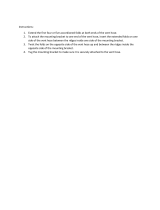
– 3 –
TABLE OF CONTENTS
NOTES FOR THE INSTALLERS ...................................................4
How to Reduce the Clearance Height of the Control Box During Move-In ................4
UNPACKING ..................................................................6
Removing Each Section From Its Skid ...........................................6
LOCATION. . . . . . . . . . . . . . . . . . . . . . . . . . . . . . . . . . . . . . . . . . . . . . . . . . . . . . . . . . . . . . . . . . . . 7
Positioning the Center Section .................................................7
Leveling the Center Section ....................................................7
ASSEMBLY ...................................................................8
Rotating Control Box 90 Degrees ...............................................8
Installing Foam Tape on Chamber Flanges & Control Box Mounting Surface ..............8
Attaching Control Box to Unload Section. . . . . . . . . . . . . . . . . . . . . . . . . . . . . . . . . . . . . . . . . 10
Positioning the Adjacent Load or Unload Sections .................................11
Leveling the Load and Unload Sections .........................................11
Joining the Sections Together .................................................11
InstallingtheCurtainBafesandUnloadAirBafe–TopofChamberFlanges ...........12
InstallingtheSaddleJoint–BottomofChamberFlanges ............................14
Control Box Connections .....................................................15
Door and Drain Interlock Switches (Prewash to Wash Tank) .........................15
Installing the Flowback Pipe (Wash to Prewash Tanks) .............................16
Installing the Drain Pipe ......................................................16
Applying Master Drain Label ..................................................16
Relocating Master Drain to Load End (Only Machines Equipped with Auto Clean,
Auto Delime, & the ASR Section) ..............................................17
Drain Back Pan Installation ...................................................20
Blower Dryer Assembly ......................................................21
Dual Rinse Pressure Switch Tubing ............................................23
ELECTRICAL CONNECTION(S) ..................................................24
Checking Motor Rotation (Three-Phase Motors) ...................................24
Separate Electrical Connections ...............................................25
Voltage Adjustment .........................................................25
ElectricalConnection–Detergent&RinseAidDispensers. . . . . . . . . . . . . . . . . . . . . . . . . . . 25
Vent Fan Control ...........................................................26
PLUMBING CONNECTIONS ....................................................26
Water Supply ..............................................................26
Fill ......................................................................26
Final Rinse ................................................................27
Drain ....................................................................27
Line Strainers ..............................................................27
Steam Supply (When Equipped) ...............................................27
SteamTankHeaters–CondensateReturnLines ..................................28
SteamBoosterHeater–CondensateReturnLine&ReliefValves .....................28
SteamBlowerDryer(WhenEquipped)–CondensateReturnLine. . . . . . . . . . . . . . . . . . . . . 28
Auto Clean Hose Connections (When Equipped) ..................................29
CONVEYOR ASSEMBLY .......................................................30
Loading and Joining the Conveyor Sections ......................................30
Conveyor Offset Side Bar ....................................................33
Adjusting the Conveyor Take-Up Unit (Load Section) ...............................34
MISCELLANEOUS ............................................................35
Vent .....................................................................35
Prewash, Wash, and Power Rinse Arms .........................................36
Dual Rinse/Final Rinse Arms ..................................................36
Automatic Soil Removal (ASR) Arms (When Equipped) .............................37
BafeSettings .............................................................38
Lower Trim Panels (Front) and Rear Panels ......................................40
Calibrating the Electric Booster Thermostat ......................................40
Conveyor Gear Motor .......................................................41
Delime Indicator Setup ......................................................41
SERVICE ....................................................................41























